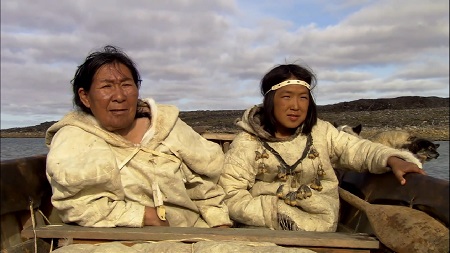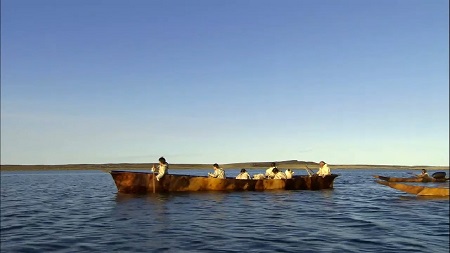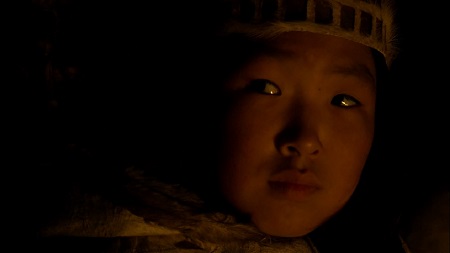
By the light of a seal oil lamp, Ninioq (played by co-director Madeline Ivalu) begins her nightly tradition of telling tales to her grandson Maniq (Ivalu’s real life grandson, Paul-Dylan Ivalu). In the darkness, these stories are as much about passing the time as they are about survival. Demonstrating how every part of life can have an undercurrent of fierce self-preservation, Marie-Hélène Cousineau and Madeline Piujuq Ivalu’s 2008 film Before Tomorrow is the story of the end of the world. In this way, the film echoes with the North American blockbuster trend of the era, the “disaster movie,” examples of which are The Core (2003), The Day After Tomorrow (2004), Cloverfield (2008) or Knowing (2009), all of which follow the post-apocalyptic narrative of a few survivors trying to cling to life after disaster. However, while these films unfold in the present or not-too-far future, Before Tomorrow takes place in 1840. Here, the end of the world has already happened, and it is not a piece of science fiction, but a part of history that has been dismissed and ignored. Here, the end of the world is the foundation of the West.
Here, the end of the world has already happened, and it is not a piece of science fiction, but a part of history that has been dismissed and ignored. Here, the end of the world is the foundation of the West.
Focusing on the importance of oral traditional within Igloolik culture, and the sharing of information between Elders and younger generations, Cousineau and Piujuq Ivalu formed the Arnait Video Productions (AVP) with Mary Kunuk in 1991. The AVP consists of a collective of female Inuit filmmakers working with folk tales and storytelling to keep history and culture strong. Before Tomorrow was the AVP’s first feature, but follows the path that its members’ previous works had paved. Films like Attagutaaluk (1992), an interview with an Igloolik Elder, Rose Ukkumaluk, who tells the story of a woman’s survival. The film is shot under a collective directorial credit. Or Umiaq (2007), directed by Ivalu and Carol Kunnuka, documentary about Elders making an umiaq, a traditional boat covered in seal skins. Ningiura (2002), directed by Mary Kunuk, is a fictional short about a grandmother and granddaughter, and looks at the relationship between traditions and the present-day realities of living in colonized Canada.
These are only a small selection of the works under the AVP umbrella, but their praxis—to focus on the multiple experiences of the Inuit, both present and past, while privileging the importance of oral traditions—is a straight line from their earliest work to their projects in development. Cousineau and Ivalu, when not directing, are also involved in other ways in most of the works, whether writing, producing or acting. These projects are always communal, but also intimate, reflecting the works of a small group of women with a shared goal. For instance, though the book Before Tomorrow is adapted from a Danish novel—Før Morgendagen (1975) by Jørn Riel, a white European man—the directors adapt this novel to tell their larger story of Inuit experiences of contact with colonizers and their repercussions.

As outlined in Isabelle Dubois’ “On the set of Before Tomorrow,”[i] the importance of tradition is not only in the narrative. Costume designer Atuat Akkitirq and art director Susan Avingaq made sure that, as much as possible, the mise-en-scène was created using Igloolik methods. As one of the actors in the film, Qalingo Tookalak, accurately sums up: “This time around, it was the real thing, not just according to white people’s imagination and stereotypes of Inuit but as we, Inuit, see it.”[ii] This was even reflected on set. In the film, the labour that Ninioq and Maniq have to do (such as drying fish and collecting pelts) was done in real life by the cast and crew, who camped out traditionally during filming. It was integral that the experiences of the characters were also had by the crew, and that their skills are still used, and viable, in the present.
Before Tomorrow is structured by the act of storytelling, opening with Maniq asking his grandmother to tell him a story. It’s an act that that can be described as similar to the project of the AVP: both communal and intimate. Each tale told has generations of knowledge behind it, but is still told by one person, often to another individual. Indeed, the power of Ninioq’s stories is reinforced by having one of the directors play her, which meta-cinematically nods to the way in which the women are creating their own worlds.

The story that Maniq requests at the beginning of Before Tomorrow is one centred on him and his grandmother, and the rest of the narrative is framed within its plot. The film begins, chronologically, with the two preparing to take the season’s fish to dry out on a nearby island, something in which Ninioq has years of expertise. Before they leave, old friends arrive. They’re welcomed by Maniq’s family, and sit together to share their own stories, with the camera placed amongst the group like another guest listening in.
One of the visitors, Kukik (Tumasie Sivuarapik), tells of his first interactions with colonizers, who are typified as drunks with firm handshakes. Any of the Western myths about colonizers being greeted as gods are gone here; they are just men with different tools, ones which Kukik and the others want. He shows the group the sharp knives and the needles he acquired, which the colonizers exchanged for sex. This story is told through ribald humour rather than any moral condemnation, and later Ninioq and her friend Kuutujuk (Mary Qulitalik) joke about whether anyone would want to sleep with them, both old women. With the camera nestled between the two women in their tent, Cousineau and Ivalu have the audience curled up with them, without distance.
Ninioq leaves with Maniq and Kuutujuk to dry the fish and Maniq’s father promises to collect them after their work. But time passes, and no one comes. Ninioq does her best to take care of her grandson and friend. Ninioq knows that death is as important as life, and with the same care she takes with her grandson, she supports Kuutujuk as she passes away, promising to tell her final dream to the woman’s son, and building a grave for her. Maniq kills a seal, and Ninioq asks him to tell her the story, so she can in turn tell his father. For Ninioq, remembering a dying mother’s love to her son, or the achievements of a boy which will instill pride in his father, are all pieces of knowledge in their own form, and important to share with others.
Eventually Maniq and Ninioq can wait no longer, and the two depart from the island to reach their homestead. Halfway through the film, they return to find an ending: their loved ones are all dead of smallpox contracted from the colonizers. Leaving behind the barren island, they find nothing remains for them at their home and they flee into the surrounding tundra. It is eventually revealed that what we just witnessed was the story Maniq asked his grandmother to tell at the beginning of the film.
Maniq and Ninioq survive on their own, aided by the Elder Ninioq’s knowledge. When attacked by wolves, she instructs Maniq on how to clean her wound. All the while she has concerns about what would happen if she were to pass away before him, expressing these anxieties to her deceased husband, his presence as real to her as Maniq’s. Ninioq’s perspective is privileged in her interactions with the spirit her grandson cannot see, as well as in the way her private thoughts and their conversations become narration.

The turn to the solitary family unit in the face of societal collapse is not unique to Before Tomorrow. A quick glance over apocalyptic fictions of the same era sees a common trope: the father and son in The Road (John Hillcoat, 2009), the make-shift family brought together to protect the last child in Children of Men (Alfonso Cuarón, 2006). The family is all that remains, and therefore must be protected at all costs. Within a family unit is a potential for a future: the children, raised by the parents, will grow up and build (or re-build) society, returning it to its former glory. It is only offspring which represent the possibility of redemption. Despite our inability to stop destruction, there is still the possibility of something new. In these films, the world has to end so the “good ones,” who simply through narrative attention will always be the protagonists, can have a new world, free of the previous world’s mistakes. Though happy endings are not always the case here, the threat (that this could happen to our world) and the promise (that if you’re good it’ll be okay), are always made clear.
But because such stories take place in the future, the markers of our world are always made present as a reminder of the likelihood of this happening. By contrast, Before Tomorrow is an end that has already happened. The intentional spread of disease and the decimation of Indigenous peoples by colonizers is a historical fact.[iii] Before Tomorrow is then a story of the end of the world, but not the kind usually presented in the West—the onscreen world was not corrupt, the disaster is not speculative but truly occurred and there’s no promise of a moral redemption.
Ninioq and Maniq stay alive for as long as they can, but as the lamp light dies, so do they. But the power of storytelling is the power of collective knowledge. Much like Inuit traditions, AVP’s storytelling power functions behind and in front of the camera. The characters do not survive, but their story remains, and bears witness to the realities of colonialism. By not following the forms of Western apocalyptic narratives, Before Tomorrow is a further challenge to the dominant narratives imposed on Inuit people. First contact was not a meeting with gods but with drunks. There is no moral reason Indigenous people died, no societal shortcoming; it was instead the brutality of colonialism.
By not following the forms of Western apocalyptic narratives, Before Tomorrow is a further challenge to the dominant narratives imposed on Inuit people.
Survival is a collective action; it’s about taking care of one another and sharing what we know, even if that does not result in our own individual survival. Having one of the co-directors play the protagonist, an Elder who perserveres through wisdom and care, brings focus to the power that comes with being a female Elder. This film is not a text of condemnation or mourning, but one of survival. What Ninioq knows needs to be remembered. What she and her family went through needs to be known. The very act of making this film, and the way it was made, is an act of survival.





